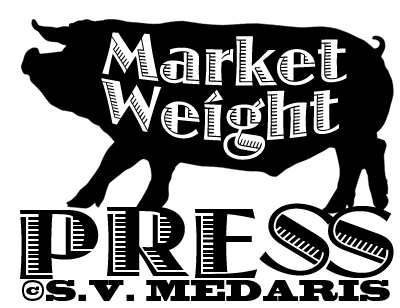For the Corn-Fed show I decided to paint a scene of Pearl and her pasture-mates.
Unlike my hogs who have free-choice feeding of a mixture of corn and other grains (they can rightly be called “corn-fed”), these hogs who live on a neighboring farm have to forage for most of their food, with only a portion of their calorie intake coming from grains. Pearl (eating the apple) is a wonderful example of old-school hog breeding, in stark contrast to modern swine genetics, and a perfect example of how genetics can determine our body type.

(3" x 4", intaglio) The Landrace, similar in body type (long and lean) to today's cross-bred hogs raised for meat
While many mixed-breed hogs raised for meat today are bred to produce long bodies with lean muscle mass, Pearl is a lard pig, an old breed raised in a time when the quality/quantity of lard in one hog was important. This breed has a lot of fat on it. Even with a pretty healthy lifestyle such as this (living off of pasture, foraging for food, with only small amounts of supplemental grain), Pearl is still incredibly fat compared to her fellow sows–it’s because of her genetics.
Granted, she’s much healthier now that she lives on pasture. Originally, she was at a museum farm (they exhibited old breeds of animals), and was kept in a pen without room to move much, and slowly became a completely sedentary hog. She couldn’t walk. When my neighbor bought her, she trained her to walk by setting the food just beyond Pearl’s reach. Pearly learned that she had to walk to get to her food. Now, she happily strolls around on pasture, and you can see that when she eats, she is absolutely in her element.




